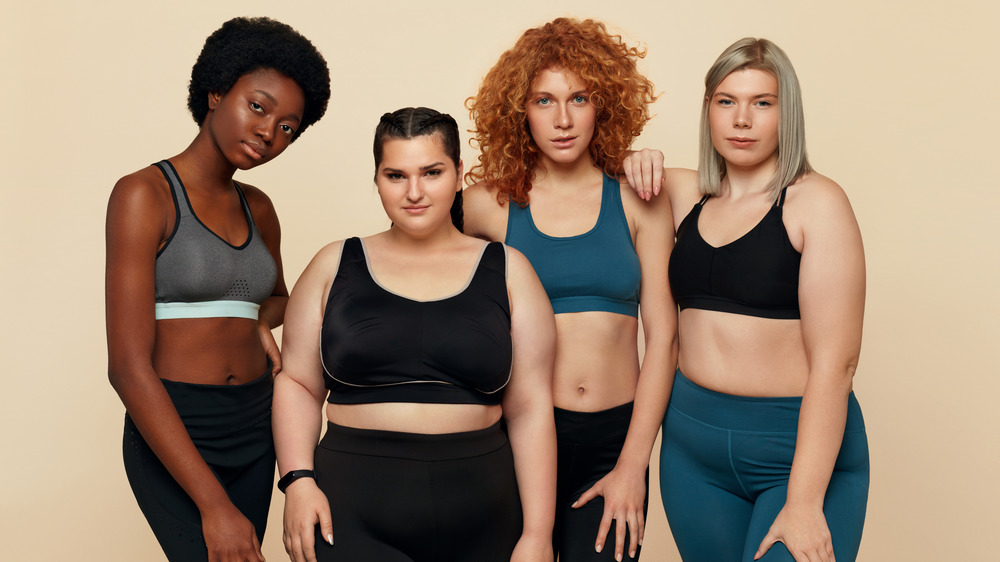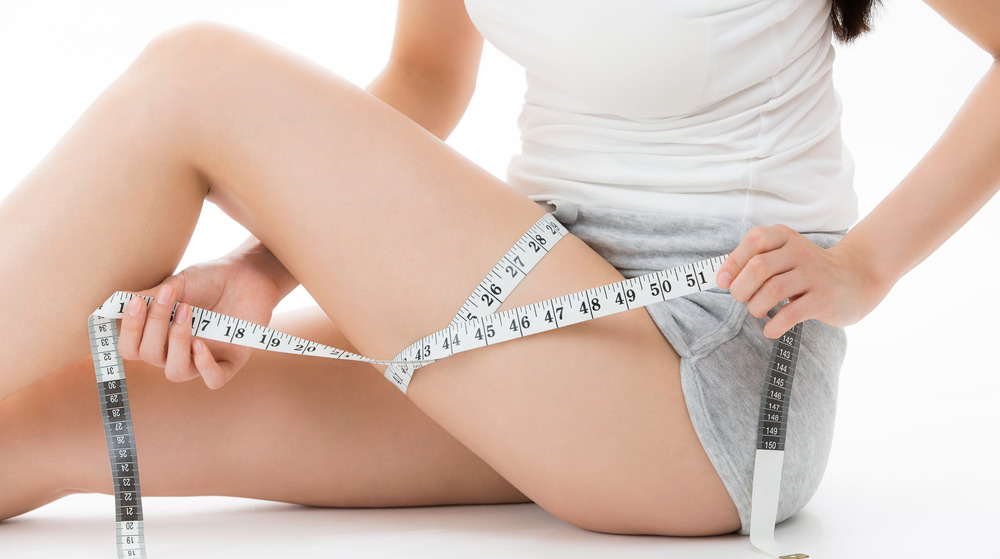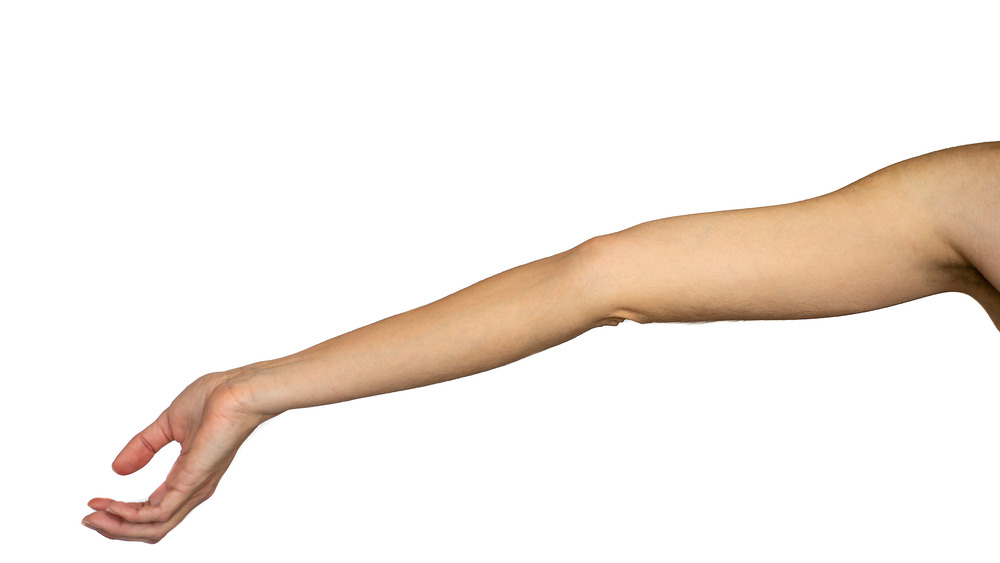Your Body Shape Can Reveal Some Surprising Things About Your Health
Your body, including height and weight, can reveal many clues about your health. A higher BMI (body mass index), or weight to height ratio, is associated with higher risk for developing certain diseases and conditions, most of which occur more often in people who have a higher percentage of body fat relative to lean muscle mass (via National Heart, Lung, and Blood Institute). However, your BMI does not tell the whole story.
First, BMI does not take into account how much of your weight might be comprised of fat versus muscle versus bone (i.e., frame size), which has been deemed relevant in other measures of healthiness of weight, according to Harvard Health Blog. Second, your body mass index does not take into account how your body weight is distributed throughout your body. Scientists study body shape because it can help fill in some of these blanks (via Penn Medicine).
The study of body shape is focused primarily on your "build," which is determined largely by genetics. Although your build doesn't change based on diet and exercise, it can help you determine how best to care for yourself. Here are some of the surprising things your body shape can reveal about your health.
What's your somatotype?
The "somatotype" system for classifying body types was devised by Dr. William H. Sheldon back in the 1940s, according to the University of Houston. The somatotype theory places all human bodies into one of three general categories: ectomorph (which tends to be on the thinner side), endomorph (which tends to be on the thicker side) and mesomorph (which tends to be more muscular). According to Dr. Sheldon, body type is genetic, and it is no more possible to change your body type than it is to change your height (once you're fully grown).
Although this system is just one way of classifying the general shape and structure of human bodies, it is one of the most well known. What many people don't know about the somatotype system, however, is that Dr. Sheldon devised it to support his psychological theories relating to criminology, as opposed to as a way of optimizing health or diagnosing health problems (via Britannica). Dr. Sheldon's research attempted to predict one's propensity toward committing certain crimes. The scientific community has discredited the somatotype theory's usefulness in criminology, but the body types identified by Sheldon still carry weight.
Those with an ectomorphic body shape may have trouble putting on weight and muscle
One of the three general somatotypes identified by Dr. William Sheldon is the ectomorphic body type, or the "ectomorph," according to the University of Houston. An ectomorph is someone with a longer, leaner build. Think: celebrities like Kate Middleton and Jeff Goldblum. Their bones, alone, are more slender than others of the same height. Although ectomorphs tend to be thin and lanky, they are nevertheless capable of gaining body fat and actually often have a higher body fat percentage than one might assume just by looking at them, according to registered dietitians Tiffani Bachus and Erin Macdonald. They explained in an article for Ace Fitness that "the best diet for an ectomorph is one that is higher in carbohydrates and calories."
Specifically, the ectomorph's diet should include about 50 to 60 percent of calories from carbohydrates, 25 percent from fat, and 25 percent from protein. Because an ectomorph's metabolism tends to be faster than other body types, they may have trouble putting on weight and muscle (via Ace Fitness). Ectomorphs may need to eat more than just three meals a day, according to the University of Houston. However, this may change as an ectomorph ages.
The endomorphic body shape accumulates body fat easily
The "endomorphic" body type, or the "endomorph," is one the three somatotypes Dr. William Sheldon identified in the '40s (via University of Houston). Endomorphs tend to have softly rounded bodies with medium to large bone structure, small shoulders and shorter limbs relative to torso length. Endomorphs can build muscle – football lineman are often endomorphs, and Jennifer Lopez is a famous endomorph who has honed a high degree of athleticism. However, they can also accumulate body fat fairly easily.
One reason may be that endomorphs have a tendency to be prone to insulin resistance, registered dietitians Tiffani Bachus and Erin Macdonald wrote in an article for Ace Fitness. That means that the insulin produced in the pancreas is not as efficient as it should be in converting blood sugar to energy. That also puts endomorphs at greater risk for obesity, diabetes, and metabolic syndrome.
To keep fat from accumulating at dangerously high levels, Bachus and MacDonald suggested an even distribution of macronutrients (30 percent carbohydrates, 35 percent protein, and 35 percent fat) with a focus on vegetable sources of carbohydrates as opposed to grains.
The mesomorphic somatotype is solid and strong
The "mesomorphic" body type, or the "mesomorph," tend to be evenly-proportioned with wider shoulders and narrower hips (via University of Houston). Mesomorphs tend to have lower body fat than endomorphs but higher body fat than ectomorphs, and mesomorphs are capable of building significant muscle on their medium-sized frames. As WebMD highlighted, mesomorphs are "naturally strong." Famous mesomorphs include Angela Bassett and Mark Wahlberg, both of whom have been known for their impressive musculature at various points in time.
Mesomorphs may need more calories than ectomorphs and endomorphs, due their higher ratio of muscle to fat and bone, registered dietitians Tiffani Bachus and Erin Macdonald revealed in an article for Ace Fitness. To stay fit and lean, it's important for mesomorphs to stay active, focusing on cardio if muscle-building isn't a priority and resistance training if muscle building is desired. The ideal diet for a mesomorph will emphasize protein as muscles gain in size.
Some bodies are more of a combination of somatotypes
Some bodies have characteristics of more than one of the somatotypes identified by Dr. William H. Sheldon. In fact, registered dietitian Abby Langer explained on her site that combination bodies are far more common than single somatotype bodies. Common combinations include ecto-endomorphs, who tend to be smaller on top than on the bottom, and endo-ectomorphs, who tend to be smaller on the bottom than on top. Any body shape that has a tendency toward endomorphic will be at some elevated risk of obesity and insulin resistance, which can be managed through diet and exercise (via Ace Fitness).
Ecto-mesomorphs can build lean muscle, but tend to be smaller-framed, according to Everyday Health. Although many characterize Madonna as a mesomorph, her frame may be slight enough for her to qualify as an ecto-mesomorph. Endo-mesomorphs can also build lean muscle, but on larger frames (via Houston Chronicle). Chris Pratt is an example of someone who possesses both mesomorphic and endomorphic qualities, and we've seen Pratt go from doughy to lean and muscular; however we have never seen him become tall and lanky because that is not possible based on his frame.
Androids and gynoids: apples and pears
The somatotypes system created by Dr. William Sheldon isn't the only way body shape have been characterized. A separate system focuses on where fat tends to be distributed in the body, according to Princeton Longevity Center, as opposed to whether the body tends to accumulate less or more body fat versus muscle. This system was devised by French physician, Dr. Jean Vague, whose seminal research paper on the topic was published in 1956 in the American Journal of Clinical Nutrition.
The system as explained by Dr. Vague presumes that fat accumulation in the upper part of the body (above the hips) is associated with higher levels of testosterone, although both men and women can have this "android" body shape, as the doctor identified it. The android body shape is sometimes referred to as the "apple" body type.
Fat accumulation in the lower part of the body (the hips and below) is associated with a less masculine hormonal profile (lower levels of testosterone), although people with this body shape, which Dr. Vague identified as "gynoid," can be male or female. The gynoid body shape is sometimes referred to as the "pear" body type. Both android and gynoid bodies can become overweight and obese, and Dr. Vague's system identifies the particular risks associated with each.
The android body shape is associated with health concerns relating to metabolic disturbance
The android body shape — in which fat is concentrated in the abdominal region — is associated not just with looking rounder in the torso, but also with a larger accumulation of visceral fat, which is fat that is stored within the abdominal cavity, including on and around organs, according to Healthline. This type of fat is more dangerous than subcutaneous fat, which accumulates between muscle and skin, according to Dr. Jean Vague, whose research paper on the topic of android versus gynoid body shape was published in 1956 in the American Journal of Clinical Nutrition. Later studies, including one published in 2016, have since backed up this finding.
"Android obesity ... leads to metabolic disturbances," wrote Dr. Vague. "It not only is associated with premature atherosclerosis and diabetes, but it is also the usual cause of diabetes in the adult in 80 to 90 per cent of the cases." These results have also been confirmed in follow-up studies over the years (via Harvard's Obesity Prevention Source). However, even in people who are not clinically obese, visceral fat raises the risk of heart disease and type 2 diabetes, physician Leann Poston confirmed to Health Digest.
The gynoid body shape is associated with fewer metabolic disturbances but comes with its own risks
The gynoid body shape, in which fat tends to be concentrated in the hips, thighs, and calves, comes with far fewer metabolic risks than the android body shape, according to Dr Jean Vague's 1956 paper published in the American Journal of Clinical Nutrition.
People with gynoid obesity are adversely affected "only by direct mechanical complications of excessive adiposity," the doctor wrote. This includes difficulty moving, abdominal pressure, limitation of lung capacity, and lower energy levels. A 2010 study published in Frontiers in Physiology found that young men with gynoid obesity run the risk of certain heart problems. As physician Leann Poston told Health Digest, carrying fat in the buttocks and legs may not involve the same sort of risk as carrying excess abdominal fat, but it still puts a strain on your body — especially your cardiovascular system.
The waist-to-hip ratio puts an objective number on the gynoid versus android dichotomy
Waist-to-hip ratio refers to the quotient you get from dividing the circumference of the waist by the circumference of the hips, Medical News Today explained. According to the World Health Organization a waist-to-hip ratio greater than 0.85 for women and 0.9 for men indicates "abdominal obesity."
Essentially, the waist-to-hip ratio offers an objective measurement of the gynoid and android body shapes identified by Dr. Jean Vague's in his 1956 paper. Doctors can use this to determine whether your weight, and the way it's distributed, may be putting your health at risk.
If you have a higher waist-to-hip ratio, you will tend to be more android-shaped, and you'll be prone to the health risks associated with the android body shape. You may also be more likely to experience cognitive deficits relating to your long-term memory and executive functions, according to a 2018 study published in the scientific journal, PeerJ. If you have a lower waist-to-hip ratio, you will tend to look more gynoid-shaped and have the relative health risks associated with gynoid body shapes.
Having larger breasts can put you at greater risk for breast cancer
Although the biggest risk factor for breast cancer in women is age (most breast cancers are found in women who are 50 years old or older, per the CDC), having larger breasts is associated with a greater risk of being diagnosed, initially, with a more advanced breast cancer.
A 2008 study published in the archives of the International Seminars on Surgical Oncology determined this association is not actually caused by having larger breasts, but by the fact that larger breasts are frequently associated with obesity, which itself is associated with breast cancer (via Cancer.org).
High breast density (when the breast tissue is dense with glandular material as opposed to fatty tissue) is also associated with an increased risk of receiving a more advanced stage of breast cancer at the initial diagnosis, a 2018 research article published in Breast Cancer Research revealed. That's because dense breast tissue makes it more difficult to detect breast tumors (both by palpation and by mammography) before they have had a chance to metastasize to nearby lymph nodes and/or distant organs, according to the CDC.
Having thin thighs could put you at risk for heart problems
Although being slimmer is generally associated with better health — especially in regards to metabolic and cardiovascular health — thick thighs may just save lives. "A small thigh circumference was associated with an increased risk of cardiovascular and coronary heart diseases and total mortality in both men and women," a seminal study out of Copenhagen, Denmark and published in The BMJ revealed.
For this study, researchers tracked over 2,800 men and women for an average of 12.5 years and found that those with bigger thighs had a lower incidence of heart disease and premature death than those with thinner thighs. For purposes of the study, "bigger" thighs were those with a circumference (measured where thigh meets buttocks) of at least 24.4 inches. And thigh circumference remained a strong, independent predictor even after the researchers adjusted for other risk factors such as smoking, exercise, alcohol use, and cholesterol levels. However, one limitation of this study, as Harvard Men's Health Watch highlighted, is that it did not take into account whether thigh circumference was due to fat or muscle content, so more research will be needed.
Being tall and thin can sometimes be a sign of this condition
Being tall and thin isn't a problem, in and of itself. However, this build can be a symptom of Marfan syndrome, according to the WebMD. "Disproportionately long arms, legs, fingers, and toes, along with flexible joints" could indicate the presence of Marfan syndrome. This syndrome is an inherited disorder that affects connective tissue throughout the body, including the blood vessels, eyes, and musculoskeletal structure.
People with Marfan syndrome are at a greater risk of another condition known as aortic dissection (a spontaneous injury to the innermost layer of the aortic artery, resulting in blood being pumped between the layers of the aortic wall, causing intense pain or even death), as explained in a report by Annals of Cardiothoracic Surgery.
If you have the physical traits associated with Marfan syndrome, it can help tip you and your doctor off to the fact that you could benefit from preventive treatment, including medication to keep blood pressure low and surgery to strengthen the aorta.
The length and shape of your fingers could help predict cancer
Your body type — even down to the size and shape of your fingers — can tell you a lot about your health. The ratio of your index finger as it relates to your ring finger may provide a clue as to a man's lifelong risk of developing prostate cancer (via Urology Times). All of the studies highlighted by the publication found that having a longer index finger (relative to the length of the ring finger) is associated with a reduced likelihood of developing prostate cancer. Likewise, a longer ring finger is associated with a higher risk of developing prostate cancer.
On the other hand, not all studies on this topic have been able to find such an association. In addition, scientists remain puzzled as to why there might even be an association. However, because men, in general, tend to have longer ring fingers compared to their index fingers, scientists hypothesize that longer ring fingers may be associated with higher testosterone exposure while in utero, and higher pre-natal testosterone exposure may increase the lifetime risk of prostate cancer (via ABC Science).
In addition to the length of your fingers, you should also pay attention to the shape — especially if they change shape. If you notice your fingers begin to look clubbed, this could indicate lung cancer or other serious conditions (via Merck Manual).














